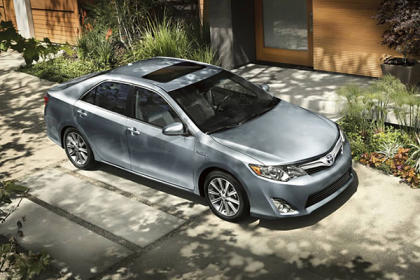Best and worst cars of 2012

MORE AT CONSUMERREPORTS.ORG
Every year, a few dozen new and redesigned models hit the streets. They’re unveiled to great fanfare at auto shows. Ads and TV commercials build the hype. And car watchers fill the social sphere with growing anticipation and buzz. But when the rubber meets the pavement at our track, some new models measure up to the expectations and others fall well short. Here are new or redesigned 2012 models that either pulled away from the pack in our testing or, well, stalled at the starting line.
The year's top vehicles

Audi A6
The redesigned A6 is a joy to drive. In our Ratings, it leapfrogged over competitors from BMW and Mercedes-Benz and tied the Infiniti M37 as our top-scoring midsized luxury car. The A6 succeeds in many areas: It’s agile, quiet, and quick. Its supercharged V-6 engine delivers potent power and a commendable 22 mpg overall, even with all-wheel drive. The ride is absorbent, and the sumptuous, impeccably finished cabin is outfitted with the latest high-tech electronic features. (See our complete Audi A6 road test and Ratings.)

Hyundai Veloster
This has been a good year for new, fun-to-drive cars. In addition to the Scion FR-S and Subaru BRZ, the Hyundai Veloster is a welcome entry in the sporty-car class. Its edgy styling stands out on the road. And its asymmetrical design—with a single rear door on the passenger side—helps make it surprisingly livable. The Veloster’s nimble handling, slick shifter, and quick, well-weighted steering add to the fun factor. Its 31 mpg overall helps at the pump. And a low, $20,000 sticker price makes it easy on your wallet. (See our complete Hyundai Veloster road test and Ratings.)

Subaru Impreza
Subaru’s 2012 redesign breathed new life into the all-wheel-drive Impreza sedan and hatchback. They are now more well-rounded, enjoyable cars, with nimble handling, roomy interiors, and absorbent rides that rival some luxury sedans. Fuel economy improved to 27 and 26 mpg overall, respectively, impressive for AWD cars. All of that helped the sedan’s test score jump 10 points to 82, enough to make it the top small sedan in our Ratings and earn it a Top Pick designation in our April autos issue.

Toyota Camry
At a time when some high-profile models have dropped in our Ratings after a reworking, the Camry’s 2012 redesign has made it more competitive. Each version we tested—four-cylinder, V-6, and Hybrid—earned a higher test score than the model it replaced. The Hybrid is especially impressive, squeezing out a best-in-class 38 mpg overall and providing a well-equipped package for less than $30,000. As a result, it now tops our family-sedan Ratings and was a Top Pick. The Camry might lack pizzazz, but this thoroughly modern sedan has few faults. (See our complete Toyota Camry road test and Ratings.)

Toyota Prius V
2012 saw the release of two new models in the growing Prius hybrid line. The subcompact Prius C was unimpressive. But the larger V wagon rates among the top models in its class. Compared with the familiar Prius hatchback, the V has been stretched in all dimensions to provide notably more cargo space and a roomier rear seat. Yet it still achieved an excellent 41 mpg overall in our testing. That combination gives the Prius V a blend of versatility and fuel economy that no other car can match. (See our complete Toyota Prius V road test and Ratings.)
Not so buzzworthy

Nissan Versa sedan
Relatively plush and comfortable-riding for a small car, the previous-generation Versa was our top-rated subcompact sedan. But its 2012 redesign sent the Versa’s test score plummeting to the bottom of the class. It gets better fuel economy of 32 mpg overall and has a roomy rear seat. But the Versa’s new cut-rate interior feels really cheap, the engine is extremely loud, acceleration is slow, and the ride is jumpy. The Versa hatchback, which wasn’t part of the latest redesign, is a different—and better—car.

Range Rover Evoque
With its cool, eye-catching styling, this new crossover SUV has created a lot of buzz. We liked the Range Rover Evoque's quick acceleration, decent fuel economy, and nicely finished cabin. But those high points can’t mask its many weaknesses, including a cramped cabin, a choppy ride, and artificial-feeling steering. In our emergency-handling tests, it scored poorly. And that sleek styling takes a toll on practical considerations, resulting in compromised visibility, driving position, and controls.

Scion iQ
The new iQ is a tiny city car that’s about the size of a Smart ForTwo. It’s super-easy to park and maneuver, and it gets a decent 34 mpg overall. But that’s the only good news. The iQ’s labored acceleration, uncomfortable seats, raucous cabin, twitchy steering, and buckboard ride strip any fun out of driving it. We also expect better gas mileage from such a small car. Overall, the iQ is one of the lowest-scoring cars we’ve tested in years.

Toyota Yaris
The original Yaris hatchback scored a dismal 52 out of 100 points in our road tests. Still, that looks good compared with the redesigned 2012 model, which dropped to 41. This spartan hatchback subjects you to a noisy cabin, uncomfortable seats, and a cheap-looking interior. It’s also slow to accelerate and has a choppy, uncomfortable ride. One redeeming quality is its excellent fuel economy of 32 mpg overall.

Volvo XC90
The latest freshening of the XC90 can be summed up as too little, too late. This SUV has remained mostly unchanged for the past 10 years while its competitors have been getting steadily better. The inline six-cylinder engine is anemic and thirsty for fuel, managing only 17 mpg overall. Handling lacks agility, the ride is stiff, and the in-car electronic features are antiquated. The bottom line: The XC90 now ranks at the bottom of our luxury-SUV Ratings.
Copyright © 2006-2012 Consumers Union of U.S., Inc. No reproduction, in whole or in part, without written permission.

 Yahoo Autos
Yahoo Autos 